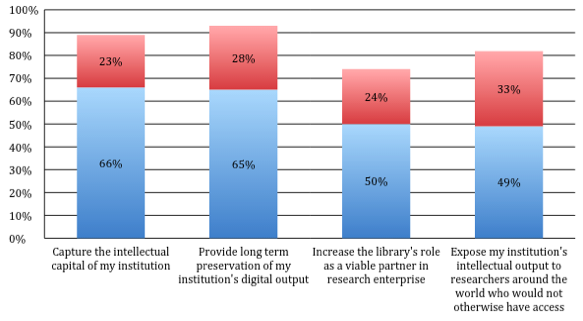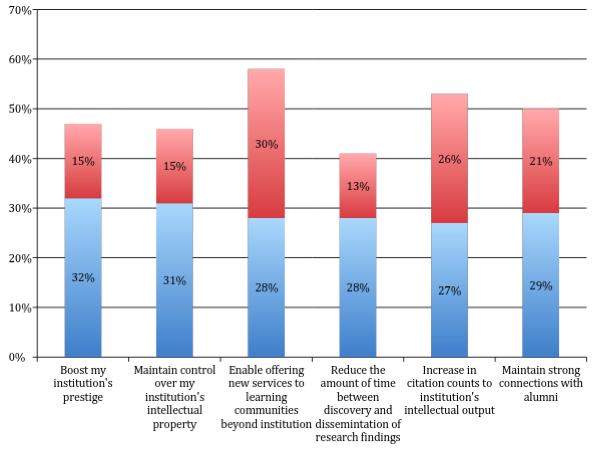|
|
|
| P R I N T E R - F R I E N D L Y F O R M A T | Return to Article |
D-Lib Magazine
March/April 2015
Volume 21, Number 3/4
Managing Digital Collections Survey Results
Liz Bishoff
The Bishoff Group
liz.bishoff@gmail.com
Carissa Smith
DuraSpace
csmith@duraspace.org
DOI: 10.1045/march2015-bishoff
Abstract
In spring 2014, DuraSpace commissioned The Bishoff Group to conduct a survey of the digital collection management practices performed by academic libraries that are not members of the Association of Research Libraries (ARL) in order to gain a better understanding of the status of their current digital content creation, management, and preservation activities. Respondents included 145 institutions across all types of academic libraries comprising two- and four-year colleges, masters, and doctorate granting universities. The survey addressed institutional content, repositories, services, future needs and plans, staff support, and the libraries' overall commitment to digital preservation. This article reports on the results of the survey.
Introduction
Beginning in December 2013, the not-for-profit organization DuraSpace began collaborating with The Bishoff Group in order to gain a better understanding of the status of digital content creation, management, and preservation activities underway in the non-Association of Research Libraries (ARL) academic library community. As part of the work, DuraSpace commissioned The Bishoff Group to conduct a Managing Digital Collections Survey of non-ARL academic libraries. The survey was conducted March 25 - April 18, 2014. The purpose of the survey was to collect information that:
- Determined if non-ARL academic libraries are involved in the management of institutional content (including faculty and student created content, and library created/acquired content) and if the repository is locally managed or hosted;
- Identified responders' perceptions about the benefits of an institutional repository/digital repository (IR/DR);
- Identified current services used by responders to support their IR/DR initiatives;
- Identified future needs and plans for IR/DR services and software;
- Defined information technology staffing used to support IR/DR;
- Explored responders' commitment to digital preservation;
- Identified the preservation service(s) respondents' use and/or are investigating and what prevents them from implementing a preservation program.
Survey Details
The Bishoff Group developed and conducted the survey with input from DuraSpace staff. The target audience for this survey was non-ARL academic libraries due to the fact that earlier studies, including the Census of Institutional Repositories in the US: MIRACLE Project Research Findings [1], found that few non-ARL institutions had implemented IR/DRs. The survey was sent to the Association of College and Research Libraries (ACRL) listservs serving the community colleges, four-year colleges, and universities. In addition, library deans and directors from the 80 Oberlin Group Libraries and the 22 University Libraries Group members received personalized emails. As a result, 49 of 80 Oberlin schools responded, a 61% response rate, and 9 of 22 members of the University Libraries Group responded, a 41% response rate. Survey responses from individuals affiliated with ARL institutions were eliminated and are not included in this report.
The survey asked each respondent to choose a Carnegie Classification for their institution. These Classifications include Associate colleges (community/junior colleges); Baccalaureate colleges (four-year colleges); Master's colleges and universities; and Doctorate-granting universities. Further analysis will use the different classifications. Of the 145 organizations that responded to the survey, 61 (42%) were from Baccalaureate colleges; 34 (23%) respondents each from Master's colleges and universities and Doctorate-granting universities; and 12 (8%) responses from Associate colleges. Deans and Directors were the major respondents at 83 (57%), while 22 (15%) were Assistant Directors. Further, 20 (14%) respondents indicated that they held other positions, including Chief Information Officers or Chief Information Officers/Library Deans.
Results
Digital Content
A significantly large number, 117 (81%) of the respondents reported that they are currently creating and/or acquiring digital content, such as the output of faculty and student research, institutional records, dissertations and theses, and digital library collections. Of the 27 (19%) respondents who indicated that they were not currently creating or collecting digital content, 14 (52%) said that they planned to in the next one to three years, 6 (22%) indicated no, while 7 (26%) did not know. These 13 respondents who answered either no or did not know exited from the survey.
Institutional Repository/Digital Repository Prevalence
Of the organizations that currently have digital content, 94 (72%) have an IR/DR that is either locally managed or hosted, 26 (20%) do not, while 11 (8%) did not know. Across all types of organizations, there is a high level of implementation of IR/DR with 51 Baccalaureate institutions reporting use of an IR/DR. Further, 73 of 102 (72%) respondents indicated that their IR/DR is a hosted service, while 29 (28%) identified that their organization is leveraging a locally managed service.
| Does your organization have an IR/DR, either a locally managed repository or a repository managed by a third party that hosts your collections? | Response Percent | Response Count |
| Yes | 72% | 94 |
| No | 20% | 26 |
| Don't know | 8% | 11 |
| Total | 100% | 131 (14 skipped) |
Institutional Repository/Digital Repository Benefits
Respondents were asked to rate the importance of a list of benefits of an IR/DR on a scale of 1 to 5, where 1 was not important and 5 was extremely important. The benefits are based on the list used in the 2007 Census of Institutional Repositories of the United States. The following seventeen choices were included in the survey:
- Capture the intellectual capital of my institution faculty and student research;
- Expose my institution's intellectual output to researchers around the world who would not otherwise have access;
- Increase the library's role as a viable partner in the research enterprise;
- Provide long term preservation of my institution's digital output;
- Enable offering better service to my institution's learning community;
- Increase the access to knowledge assets including audio, video, data sets, etc.;
- Boost my institution's prestige;
- Maintain control over my institution's intellectual property;
- Enable the offering of new services to learning communities beyond my institution;
- Reduce the amount of time between discovery and dissemination of research findings;
- Increase in citation counts to my institution's intellectual output;
- Reduce user dependence on my library's print collections;
- Provide a means of promoting undergraduate research activity;
- Maintain strong connections with alumni;
- Provide a platform for my library's e-publishing program;
- Supports my institution's open access mandate; and
- Supports my institution's data management policy and plan.
Figure 1 below shows the four most frequently selected benefits.

Figure 1: Most Frequently Selected Benefits
("Very important" appear in red and "extremely important" appear in blue.)
Benefits selected as "somewhat important" and "important" are shown in Figure 2 below. Of the benefits listed as not very important, respondents selected reducing user dependence on library's print collections most often (42%), followed by supporting institution's open access mandate (32%) and providing a platform for library's e-publishing program (24%).

Figure 2: Other Benefits Chosen
("Somewhat important" appear in red and "important" appear in blue.)
Digital Preservation Policies
Respondents indicated that there is an overall commitment to digital content preservation at their organizations with 66 positive responses (66%). However, 19 (19%) individuals indicated that there is not a commitment to digital preservation at their organization and 15 (15%) did not know. Of 100 respondents, exactly half 50 (50%) indicated that they are actively preserving content while 35 (35%) noted they were planning on implementing a digital preservation program in the future. Ten (10%) and 5 (5%) responded that they are not preserving content or didn't know, respectively.
When asked what was preventing the implementation of a digital preservation program, the following reasons were identified.
| What is preventing your library from implementing a digital preservation program? (select all that apply) | Response Percent | Response Count |
| Lack of funding | 73% | 38 |
| Other priorities | 56% | 29 |
| Lack of technical expertise | 23% | 12 |
| Other | 23% | 12 |
| Lack of administrative support | 21% | 11 |
| We don't know where to start | 8% | 4 |
| Don't know | 2% | 1 |
| Total | 100% | 52 (93 skipped) |
Digital Preservation Practices
When asked which digital preservation strategies respondents' libraries have implemented, 66 individuals selected data backup followed by 32 choosing outsourcing to an externally managed preservation repository. Quite a few respondents opted to describe other alternatives in the form of adding a written comment to the survey. These optional responses included: cloud space for limited digital assets, DuraCloud, APTrust, and ResourceSpace.
In regards to funding digital preservation activities, many respondents either chose funding through another line in the regular budget (37 responses) or don't know (32 responses). Further responses to this inquiry were quite dispersed suggesting that direct funding for preservation activities is not standardized in the non-ARL academic library community.
Key Findings
Creation/acquisition of digital content
One hundred seventeen of the 145 (81%) respondents report that they are currently creating and/or acquiring digital content, such as the output of faculty and student research, institutional records, dissertations and theses, and digital library collections. Furthermore, 14 of the 27 (52%) respondents who indicated that they were not currently creating or collecting digital content noted that they planned to create or acquire digital content in the next one to three years.
Implementation of an IR/DR
Ninety-four of the 145 (65%) respondents have a locally managed or hosted IR/DR. Of those who have not implemented an IR/DR, Associate and Baccalaureate colleges comprised the largest group that had not implemented, with 8 and 10 respondents, respectively.
Hosted versus locally managed IR/DR
The majority of the IR/DR are using hosted services. Of the respondents, 73 respondents use hosted services, 29 are locally managed.
Key features for IR/DR
Survey respondents indicated important features for future IR/DR enhancements including greater capacity for handling digital preservation, friendlier digital content submission, (greater) availability of hosted services, and reduced local IT support.
Digital preservation
Digital preservation is a priority as respondents indicated that they have a commitment to digital preservation through mission/strategic plans. Further, respondents indicated that they have executed digital preservation programs largely through participation in collaborative efforts such as Portico and LOCKSS. However when asked about barriers to implementation of digital preservation programs they identified: lack of funding, other priorities, lack of expertise, lack of administrated support, and not knowing where to start.
Conclusions
This survey of the non-ARL academic library community was undertaken to better understand the state of digital content management activities including digital preservation policies and practices. Based on the key findings the following conclusions were drawn:
- Non-ARL libraries and digital collections: Since the 2007 MIRACLE Project study, there has been widespread implementation of digital content management programs and IR/DRs in non-ARL academic libraries. As a result, the survey identified the trend of libraries now being able to focus their concerns and efforts on growing their collections, expanding the use of the collections, as well as addressing the issues around long term access to the collections through digital preservation.
- Access versus preservation: Digital preservation is a high priority in the non-ARL academic library community, in spite of the fact that few of the respondents had campus-wide open access mandates or indicated a need to support research data management. As the target of the survey was Baccalaureate and Master's degree granting institutions this particular finding in the survey is a logical conclusion.
- Hosted versus locally managed services: Hosted services are being rapidly adopted by the non-ARL academic community.
Future Work
Based on the conclusions drawn from the survey, several themes became apparent that further research and resource development will help to better address. Specifically, the following categories emerged:
- Comparison of hosted service options: Academic libraries see hosted services as a viable technology strategy and, therefore, there has been rapid adoption of hosted services for IR/DRs. The features and functionality of hosted services vary widely, particularly as relates to their digital preservation service capabilities. A side-by-side comparison of the functionality and available options would advance the use of hosted services, and assure that academic libraries can realize their goal of long-term access to and use of their collections.
- Opportunity offered through hosted services: Today's hosted services offer benefits not available in most locally managed IR/DR software. The hosted solutions available currently address many of the future features identified in the survey such as the need to integrate digital preservation with the IR/DR service, the need to reduce dependence on local IT, and the need for easier loading of collections. A further analysis of the available services could be useful to the non-ARL and broader academic library community.
- Barriers to implementation of a digital preservation program: At the same time that hosted services address the future features detailed above, they inherently solve the expressed barriers — the lack of local expertise and other priorities — that have prevented implementation of digital preservation programs in the past. By offering a full end-to-end hosted repository service that incorporates digital preservation functionality, the academic library has a single decision making process that can be incorporated in the work already underway to implement an IR/DR, such as provisioning funding, getting administrative support, and determining where to start. Resources that assist organizations in making decisions, evaluating content and collections, and selecting the tools and services that best meet their needs and budget could be of great use.
Since this survey was conducted, the Digital POWRR (Preserving Objects with Restricted Resources) research project published From Theory to Action: Good Enough Digital Preservation for Under-Resourced Cultural Heritage Institutions [3] that addresses some of the suggestions mentioned here. We look forward to more work taking place in these important areas.
References
[1] Markey, Karen, et al. Census of Institutional Repositories in the United States: MIRACLE Project Research Findings. Washington, DC, CLIR, February, 2007.
[2] Nykanen, Melissa. (2011) Institutional Repositories at Small Institutions in America: Some Current Trends, Journal of Electronic Resources Librarianship. 23: 1, 1-19. http://doi.org/10.1080/1941126X.2011.551089
[3] Schumacher, Jaime, et al. (2014) From Theory to Action: Good Enough Digital Preservation for Under-Resourced Cultural Heritage Institutions. Huskie Commons, Northern Illinois University.
About the Authors
 |
Liz Bishoff is the owner of The Bishoff Group, a library and cultural heritage organization consulting organization. Ms. Bishoff works with archives, libraries and museums on various aspects of their digital initiatives, including development of digital plans, adoption of standards and best practices, and preservation programs. Since 2005 she has conducted more than 45 digital preservation readiness assessments, and served as faculty on several IMLS and NEH funded workshops. She has held senior management positions at OCLC and BCR. She is a member of ALA and holds an MLS from Rosary College, and has post-graduate work in public administration at Roosevelt University. |
 |
Carissa Smith is the product manager for the DuraCloud and DSpaceDirect services from the DuraSpace not-for-profit organization. Ms Smith works with a wide range of organizations including university libraries and archives, state and government agencies, and cultural heritage institutions assisting them in their digital preservation, open access, and repository needs. She has presented at various conferences including the Library of Congress Digital Preservation meeting, the Open Repository Conference, the Digital Library Federation forum, and ALA. She holds a BS from Syracuse University in Information Management and Technology. |
|
|
|
| P R I N T E R - F R I E N D L Y F O R M A T | Return to Article |